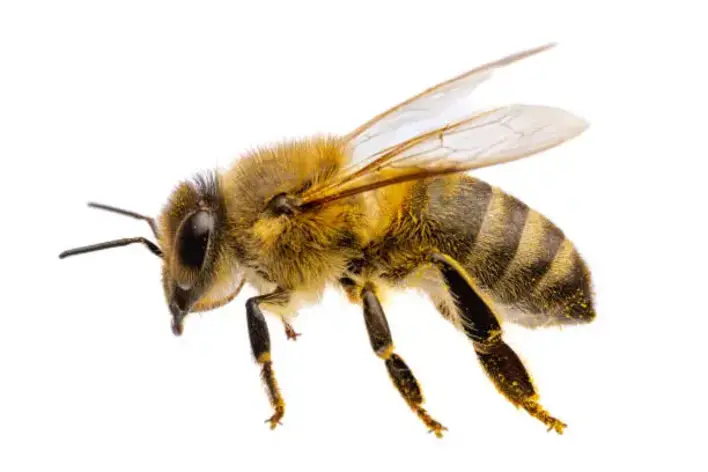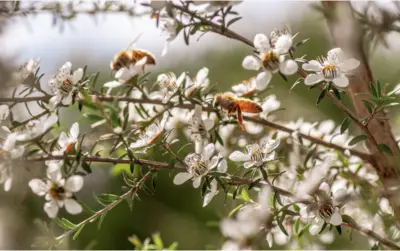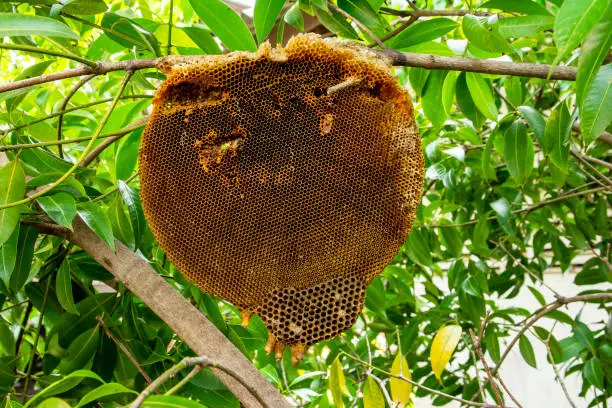Carpenter Bee vs Honey Bee
Carpenter bees and honey bees, while both integral to the world of pollinators, represent distinct species with unique characteristics and behaviors. This article aims to provide a brief overview of these two bee types, shedding light on their taxonomy, physical attributes, nesting behaviors, and ecological roles.
Understanding the differences between carpenter bees and honey bees is crucial for appreciating their individual contributions to ecosystems, agriculture, and our daily lives. This exploration will unravel the fascinating distinctions that make these bees both remarkable and vital to the balance of nature.
What is a Honey Bee?
Honey bees (genus Apis) are eusocial insects known for their complex hive structure, organized colonies, and vital role in pollination and honey production. They exhibit a caste system with workers, drones, and a queen, working collaboratively for the benefit of the hive. Honey bees contribute significantly to agriculture and ecosystems through their pollination activities, ensuring the reproduction of flowering plants.

What is a Carpenter Bee?
Carpenter bees (genus Xylocopa) are solitary bees recognized for their unique nesting behavior. Unlike honey bees, carpenter bees do not form large colonies but prefer to create individual nests in wood structures, earning them the name “carpenter.” While they also contribute to pollination, carpenter bees can be notable for causing damage to wooden structures, where they excavate tunnels for nesting. Understanding the distinctions between honey bees and is crucial for effective pest management and conservation efforts.
Read More: Do Carpenter Bees Make Honey?

Taxonomy and Classification of Carpenter Bees:
Kingdom: Animalia
Phylum: Arthropoda
Class: Insecta
Order: Hymenoptera
Family: Apidae
Genus: Xylocopa
Taxonomy and Classification of Honey Bees:
Kingdom: Animalia
Phylum: Arthropoda
Class: Insecta
Order: Hymenoptera
Family: Apidae
Genus: Apis
Physical Characteristics of Carpenter Bees and honey bees
| Physical Characteristics | Carpenter Bees | Honey Bees |
| Size | Larger (up to 1 inch/25 mm) | Smaller (around 0.5 inches/12 mm) |
| Color | Shiny black, some with yellow markings | Brownish-orange with black and amber stripes |
| Anatomical Structures | Robust body, relatively hairless, females have stinger | Smaller body, more body hair, worker bees have a stinger |
Nesting Behavior
Carpenter bees exhibit unique nesting behavior, boring into wood to create galleries for their nests. This behavior can lead to damage in wooden structures. In contrast, honey bees construct intricate wax combs within hives for nesting. The nesting habits of these two bee species differ significantly in terms of construction and impact on their surroundings.
Table of Habitat Preferences
This table outlines the differences in habitat preferences between carpenter bees and honey bees, emphasizing their distinctive nesting behaviors and adaptability to various environments.
| Aspect | Carpenter Bees | Honey Bees |
| Preferred Habitat | Wood-rich environments, such as decks and fences | Various environments, including trees, rocks, and man-made hives |
| Nesting Behavior | Wood-boring activities in wooden structures | Construct wax comb hives in diverse locations |
| Adaptability | Specialized for wood habitats | Versatile, capable of nesting in various settings |
| Man-made Structures | Often choose wooden structures for nesting | Can inhabit man-made hives, enhancing apiary management |
| Natural Landscape | Thrive in areas with ample wooden resources | Colonies can be found in diverse natural landscapes |
| Environmental Impact | Wood-boring behavior may affect wooden structures | Generally less impact on natural surroundings |
Foraging Habits
| Aspect | Carpenter Bees | Honey Bees |
| Foraging Behavior | Collect pollen and nectar for themselves and offspring | Forage for pollen and nectar to feed the entire colony |
| Floral Preferences | Often favor wood-boring plants and trees, such as fruit trees | Have a broad range of floral preferences, visiting various flowering plants |
| Nectar Collection | Use their long tongues to reach into flowers and extract nectar | Utilize proboscis (tongue) to extract nectar from flowers |
| Pollen Collection | Gather pollen on specialized hairs on their bodies | Collect pollen in pollen baskets on their hind legs |
Colony Structure of Honey Bees
Honey bee colonies are highly organized and consist of three main castes: workers, drones, and a single queen. Workers, the majority of the colony, are females responsible for various tasks like foraging, nursing, and hive maintenance. Drones are male bees with the primary role of mating with a queen. The queen is the sole reproductive female, laying eggs and governing the hive. This social structure promotes division of labor and efficient colony functioning.
Colony Structure of Carpenter Bees
In contrast, carpenter bees are solitary creatures. Each female constructs her own nest, usually in wood, where she lays eggs and provisions the nest with pollen and nectar. There is no worker caste, and males do not contribute to nest-building or provisioning. This solitary lifestyle means that each female carpenter bee is responsible for all aspects of reproduction and nest maintenance, operating independently of other bees.
Reproductive Strategies of Carpenter Bees
Carpenter bees employ a solitary reproductive strategy. Each female carpenter bee constructs her own nest, typically in wood, where she lays eggs and provisions the cells with pollen and nectar. The female carpenter bee is solely responsible for the care and development of her offspring. This individualistic approach contrasts with the social structure of honey bees.
Reproductive Strategies of Honey Bees
Honey bees have a highly complex reproductive system within the colony. The queen bee is the sole fertile female responsible for laying eggs. She mates with drones during a nuptial flight and stores the sperm for future egg-laying. Worker bees, which are sterile females, assist in caring for the brood and maintaining the hive. Drones, the male bees, have the primary role of mating with a queen. The intricate division of reproductive labor contributes to the colony’s success and survival.
Pollination Services of Carpenter Bees
Carpenter bees are effective pollinators, particularly for certain types of flowers. While they may not be as specialized as some other bee species, they contribute to the pollination of a variety of plants. Carpenter bees collect pollen as a food source for their offspring, inadvertently transferring pollen between flowers during their foraging activities.
Pollination Services of Honey Bees
Honey bees are renowned for their exceptional pollination services. They have specialized pollen baskets on their hind legs, allowing them to collect large quantities of pollen to bring back to the hive. Their foraging behavior and ability to communicate the location of floral resources make honey bees crucial for the pollination of numerous crops, fruits, and wildflowers, playing a vital role in agricultural and natural ecosystems.
Impact on Wooden Structures
Carpenter bees can have a significant impact on wooden structures. Females bore into wood to create nests, causing structural damage over time. While individual tunnels are not extensive, multiple nests can weaken and compromise the integrity of wooden components like decks, eaves, and siding.
Honey bees, in contrast, do not pose a direct threat to wooden structures. They build their hives using beeswax and other materials, typically avoiding wood-boring activities. Honey bee colonies are often located in natural cavities or man-made hives, and their presence does not result in the structural damage associated with carpenter bees.
Human Interaction and Concerns about Carpenter Bees
Structural Damage: Common concern involves the potential impact of carpenter bees on wooden structures. While they may tunnel into wood, significant damage is rare and can be mitigated by implementing preventive measures like painting or staining wood.
Perceived Aggression: Carpenter bees are generally non-aggressive, with males lacking stingers, and females rarely using theirs unless provoked. Educating residents about their behavior helps alleviate fears.
Human Interaction and Concerns about Honey Bees
Stinging Incidents: Misconceptions about honey bee aggression can lead to concerns. Honey bees are typically docile, stinging only in defense. Proper education on bee behavior reduces the risk of stinging incidents.
Swarm Anxiety: Honey bee swarms are temporary and not necessarily threatening. Beekeepers can assist in relocating swarms safely. Public awareness programs help address fears associated with swarm sightings.
Shared Threats
Habitat Loss
Urbanization and deforestation impact both carpenter bees and honey bees by reducing suitable nesting and foraging sites.
Climate Change
Altered weather patterns and environmental shifts affect floral availability, disrupting foraging and nesting behaviors for both species.
Bee-Friendly Gardening Tips
Plant Diverse Flowers
Cultivate a variety of flowers with different shapes, colors, and bloom times to attract a range of bee species, including carpenter bees and honey bees.
Choose Native Plants
Opt for native plant species, as they are well-adapted to the local ecosystem and provide familiar nectar and pollen sources for bees.
Include Bee-Friendly Herbs
Herbs like lavender, mint, and basil are not only aromatic but also attract bees with their abundant nectar.
Provide Water Sources
Create a shallow water source, such as a birdbath with stones for perching, to help bees stay hydrated.
Avoid Pesticides
Minimize or eliminate the use of pesticides, as they can be harmful to bees. Choose natural alternatives or integrated pest management methods.
Plant in Clumps
Grouping plants in clusters makes it easier for bees to forage efficiently and increases the visibility of your garden to passing bees.
Consider Bloom Seasons
Plan your garden to have blooms throughout the growing season, ensuring a continuous food source for bees.
Leave Some Untouched Spaces
Allow a portion of your garden to grow naturally, providing nesting sites for ground-nesting bees.
Provide Nesting Materials
For carpenter bees, leave untreated wood or create bee hotels with drilled holes for nesting. Honey bees prefer cavities, so consider leaving some dead branches intact.
Educate Others
Share your knowledge about bee-friendly gardening with neighbors and community members to collectively create a network of supportive environments for bees.
By incorporating these tips into your gardening practices, you contribute to the well-being of both carpenter bees and honey bees, fostering a thriving and diverse bee-friendly ecosystem.
Bee Identification
Body Size and Shape
Carpenter bees are generally larger and stouter than honey bees. Note the size and overall body shape when observing bees in your vicinity.
Coloration
Carpenter bees often have a shiny black abdomen, while honey bees display more varied colors, including browns and yellows, with distinct stripes.
Hairiness
Honey bees are typically hairier than carpenter bees, which may have a more polished appearance. Observe the level of hair coverage on the bee’s body.
Behavior
Carpenter bees are solitary and may be seen hovering around wooden structures. Honey bees are social and live in colonies, flying to and from hive entrances.
Pollen Baskets
Honey bees have specialized structures called pollen baskets on their hind legs for carrying pollen. Carpenter bees lack this feature.
Nesting Sites
Carpenter bees may create nesting holes in wood, while honey bees build wax combs in hives. Observe where the bee is entering and exiting to identify its nesting habits.
Flight Patterns
Carpenter bees may exhibit more erratic flight patterns, especially around wooden structures, while honey bees typically have purposeful and directed flight paths.
Location
Carpenter bees are often found near wooden eaves, decks, or fences. Honey bees can be spotted near flowers, especially if there’s a hive nearby.
By paying attention to these key characteristics, you can enhance your ability to distinguish between carpenter bees and honey bees, contributing to a better understanding of these essential pollinators.
Common Myths and Facts
Myth 1: Carpenter Bees Are Destructive and Harmful
Fact: While carpenter bees can create nesting holes in wood, they rarely cause significant structural damage. Their impact is generally limited to aesthetic concerns.
Myth 2: All Bees Sting
Fact: Only female bees can sting. Carpenter bees, especially males, are less aggressive, and honey bees typically sting in defense of their hive.
Myth 3: Honey Bees Are Always Yellow and Black
Fact: Honey bees can vary in color, with some having brown or even darker hues. It’s not accurate to rely solely on color for identification.
Myth 4: Carpenter Bees Live in Hives
Fact: Carpenter bees are solitary insects and don’t live in colonies or hives. They create individual nests in wood.
Myth 5: All Bees Are Aggressive
Fact: Most bees, including honey bees and carpenter bees, are not inherently aggressive. They usually only become defensive if they feel threatened.
Myth 6: Carpenter Bees Don’t Pollinate
Fact: Carpenter bees are important pollinators, contributing to the pollination of various plants while foraging for nectar.
By dispelling these myths, we aim to foster a better understanding of carpenter bees and honey bees, promoting coexistence and appreciation for their vital roles in ecosystems.
FAQs
What is the main difference between carpenter bees and honey bees?
Carpenter bees are solitary nesters in wood, while honey bees live in colonies and build wax hives.
What is the primary distinction between bumble bees and honey bees?
Bumble bees and honey bees belong to different genera and have distinct behaviors, nesting habits, and appearances. Read More
Why are honey bee colonies more complex than carpenter bee nests?
Honey bee colonies have a structured social hierarchy with workers, drones, and a queen, whereas carpenter bees are solitary.
What sets Italian queen bees apart from other honey bee subspecies?
Italian queens are a distinct subspecies known for their gentle temperament, prolific egg-laying, and adaptability to various climates. Read More
How can I discourage carpenter bees without harming them?
Providing alternative nesting sites and treating wooden structures can deter carpenter bees without causing harm.
Can carpenter bees and honey bees coexist in the same area?
Yes, both species can coexist, and creating a bee-friendly environment benefits both carpenter and honey bees.





